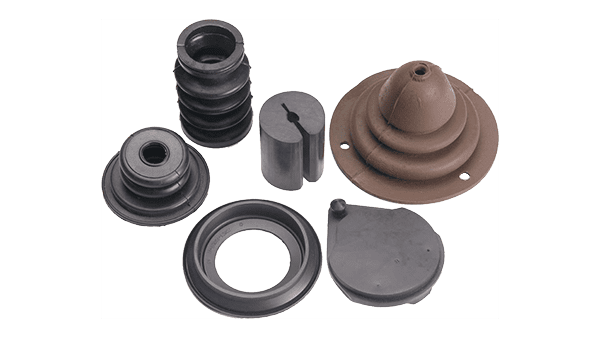Nitrile Rubber
Nitrile rubber, also called nitrile-butadiene rubber (NBR, Buna-N), is a synthetic rubber that provides excellent resistance to petroleum-based oils as well as mineral and vegetable oil. Nitrile rubber is more resistant than natural rubber when it comes to heat aging - often a key advantage, as natural rubber can harden and lose its damping capability. Nitrile rubber is also a great material choice for applications that require abrasion resistance and metal adhesion.

What is nitrile rubber used for?
Nitrile rubber performs well in carburetor and fuel pump diaphragms, aircraft hoses, oil seals and gaskets as well as oil-lined tubing. Due to its versatility and strong resistances, nitrile material is used in applications involving not only oil, fuel and chemical resistance, but those applications requiring resistance to heat, abrasion, water, and gas permeability. From oil rigs to bowling alleys, nitrile rubber can be the right material for your application.
Properties
♦ Common Name: Buna-N, Nitrile, NBR
• ASTM D-2000 Classification: BF, BG, BK
• Chemical Definition: Butadiene Acrylonitrile
♦ General Characteristics
• Aging Weather/ Sunlight: Poor
• Adhesion to Metals: Good to Excellent
♦ Resistance
• Abrasion Resistance: Excellent
• Tear Resistance: Good
• Resistance: Good to Excellent
• Oil Resistance: Good to Excellent
♦ Temperature Range
• Low Temperature Usage: -30°F to -40°F | -34°C to -40 °C
• High Temperature Usage: Up to 250°F | 121°C
♦ Additional Properties
• Durometer Range (Shore A): 20-95
• Tensile Range (P.S.I): 200-3000
• Elongation (Max %): 600
• Compression Set: Good
• Resilience/ Rebound: Good

Caution: Nitrile should not be used in applications involving highly polar solvents such as acetone, MEK, ozone, chlorinated hydrocarbons and nitro hydrocarbons.
Applications
Nitrile rubber's material properties make it an excellent solution for sealing applications.It also has excellent resistance to petroleum products and can be compounded for service of temperatures up to 250°F (121°C). With these temperature resistances, the right nitrile rubber compounds can withstand all but the most severe automotive applications.Other applications that benefit from nitrile rubbers properties which can be custom compounded and molded include:

♦ Oil resistant applications
♦ Low temperature applications
♦ Automotive, marine and aircraft fuel systems
♦ Nitrile roll covers
♦ Hydraulic hoses
♦ Nitrile tubing
Examples of applications and industries where nitrile (NBR, buna-N) is used include:
Automotive Industry
Nitrile, also known as buna-N, has oil resistant properties that make it the perfect under-hood material.
Buna-N is used for
♦ Gaskets
♦ Seals
♦ O-rings
♦ Carburetor and fuel pump diaphragms
♦ Fuel systems
♦ Hydraulic hoses
♦ Tubing
Bowling Industry
Nitrile rubber (NBR, buna-N) is resistant to lane oil and is typically used for
♦ Bowling pin setters
♦ Roller bumpers
♦ Anything that comes into direct contact with lane oil
Oil & Gas Industry
♦ Seals
♦ Tubing
♦ Molded shapes
♦ Rubber-to-metal bonded components
♦ Rubber connectors
Benefits & Advantages
Nitrile offers strong resistance to heat aging - a key advantage over natural rubber for the automotive and bowling industries.
Benefits of using nitrile rubber:
♦ Excellent solution for sealing applications
♦ Good compression set
♦ Abrasion resistance
♦ Tensile strength
♦ Resistance to heat
♦ Resistance to abrasion
♦ Resistance to water
♦ Resistance to gas permeability

Caution: Nitrile should not be used in applications involving highly polar solvents such as acetone, MEK, ozone, chlorinated hydrocarbons and nitro hydrocarbons.
Interested in neoprene for your application?
Call 1-888-759-6192 to find out more, or get a quote.
Not sure which material you need for your custom rubber product? View our rubber material selection guide.
Order Requirements
